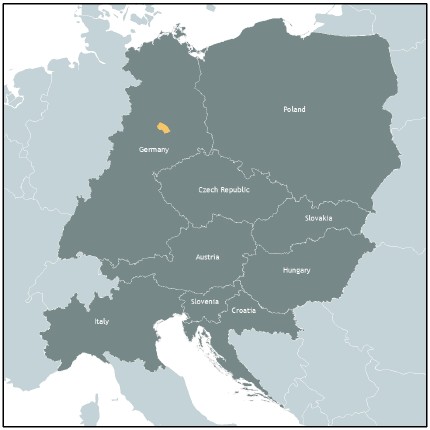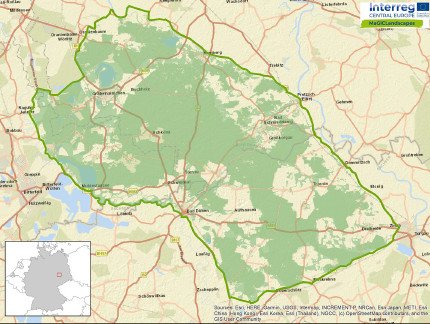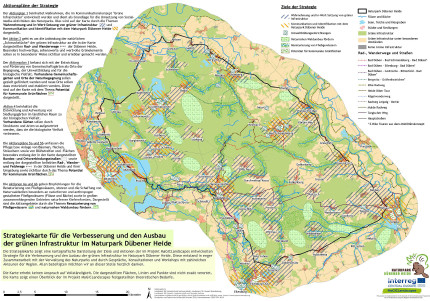Dübener Heide Nature Park
Green Infrastructure Strategy and Action Plan

|

Case study area Dübener Heide Nature Park in Saxony and Saxony-Anhalt, Germany |
Description of the area
The Dübener Heide is a cross-border landscape area on the southern edge of the North German lowlands between the northern Saxony and southern part of Saxony-Anhalt. Key elements are the river valleys of the Elbe and Mulde in the west, north and east. In the north, the Dübener Heide is characterised by the post-mining landscapes, a legacy of the historic extraction of brown coal. The central core of the park is mixed woodland, the largest in Germany.
The landscape of heath, bog, marshland, woodland, waterways, ponds, grassland and agriculture is home to a wide range of species including cranes, otters, ospreys and the beaver, the park’s symbol. It is also home to people with scattered small settlements and larger towns such as Bad Düben and Schmeideberg. The park is a popular destination for residents and visitors alike. Cultural attractions and events add to the multifunctional attraction of the park. The park is a National Nature Reserve and a Special Protection area.
The Dübener Heide is highly valued by local communities and their contribution to its conservation is both impressive and considerable. With almost 400 members the Verein Dübener Heide e.V. (Dübener Heide Association) is organised into nine local groups. The association has demonstrated the effectiveness of community involvement and ownership of conservation activities in the park and is the perfect example of professional bottom up conservation efforts supported by established and effective funding mechanisms.
Issues
Although in principle the area offers a well-preserved and diverse green infrastructure, it is important to continue to protect, continuously expand and secure it for future generations, especially so for a tourist recreation area like the Dübener Heide.
There is a partial lack of grey infrastructure that encourages small and medium-sized enterprises to settle in the region (e.g. lack of rail connections). The expansion of broadband and digitalisation as well as the development of cycle paths and other tourism developments are currently ongoing and these plans and developments must be evaluated and possibly adapted with regard to their impact on the existing and future green infrastructure.
The Dübener Heide is subject to relatively strong demographic changes and migration processes. A lack of perception, identification and access to green infrastructure has also been identified. There are also many challenges posed by climate change such as increasing drought, falling water levels in the bogs, calamities, heavy rainfall events.
Through the evaluation of the public benefits for GI and through the workshops and consultations with local actors and associated partners during the project, a deficit was identified in the perception and appreciation of existing and exceptional green structures and elements as well as in the communication and identification with the Dübener Heide Nature Park and the region.
Challenges
For many of these challenges, the concept of green infrastructure can offer solutions. An analysis of existing guidelines, planning instruments and political strategies showed that a large number of these documents for the Dübener Heide region referenced the elements and benefits of green infrastructure. However, the term or strategic concept of green infrastructure is almost unknown or applied. Several planning and strategy documents were revised and updated (e.g. the maintenance and development concept for the nature park). This created the opportunity to anchor the concept of green infrastructure, methods and tools developed and tested in the MaGICLandscapes project in planning and contribute directly to the improvement of green infrastructure. The perception and communication of the advantages of the green infrastructure concept is also a challenge and if there is no adequate appreciation, the benefits for people will only unfold to a limited extent and currently communication of the nature park so far only reaches the target groups to a limited extent.
HOW THE STRATEGY WAS DEVELOPED
Outline of key themes, priorities and directions for the GI Strategy and Action Plan
As a result of the processes carried out, five main themes were defined for the strategy and action plans for the expansion and improvement of green infrastructure in the Dübener Heide Nature Park. Firstly, involving and informing residents about the benefits of GI and connecting people with nature (in terms of health and well-being and tourism and recreation). Secondly, improving the perception and value creation as well as the communication and identification with GI in the region. These first two themes were addressed through the development of the Communication Concept “Increasing the perception of the advantages and functions of green infrastructure in the Dübener Heide Nature Park"). With this concept, target groups that have not yet been reached are specifically addressed and the advantages of green infrastructure can be communicated. In addition to an analysis of the current situation (SWOT), the concept provides strategic recommendations and proposals, on the basis of which concrete Projects and measures on the Social media channels from the nature park administration can be implemented.
A third theme is access to, and connection with the existing green infrastructure. A further focus is education for sustainable development and the topic of expanding and improving elements of GI. Finally, adapting and reacting to climate change is also a major theme.
Spatially, the cities and settlements in the Dübener Heide and their connection to the surrounding core areas of green infrastructure are of particular importance. A key role is played by the management of the nature park. As a result, the following table was compiled, which reflects the advantages of GI according to priority and the strategies and partners involved for the Dübener Heide.
GI Benefit | Strategic Tools/Policies | Partners | |||
| Health & well-being | Regional Plan Leipzig-Western Saxony | Dübener Heide Nature Park | |||
| Adaptation to climate change | German Strategy for Adaptation to Climate Change Regional Plan Leipzig-Western Saxony Integrated climate protection concept Integrated urban development concept (InSEK) LEADER Development Strategy (LES) Dübener Heide Maintenance and development concept for the Dübener Heide Nature Park (PEK) | Dübener Heide Nature Park Cities and municipalities Regional Management Dübener Heide Nature conservation authorities | |||
| Tourism & recreation | Cycle traffic concept of the district of Nordsachsen Networked mobility Dübener Heide LEADER Development Strategy (LES) Dübener Heide Maintenance and development concept for the Dübener Heide Nature Park (PEK) Location marketing concept Dübener Heide | Dübener Heide Nature Park Cities and municipalities Regional Management Dübener Heide Tourism managers | |||
| Conservation benefits | Biotope network Saxony Biodiversity Saxony 2020 Maintenance and development concept for the Dübener Heide Nature Park (PEK) | Dübener Heide Nature Park Cities and municipalities Regional Management Dübener Heide Nature conservation authorities Landscape conservation associations NABU, BUND | |||
| Disaster prevention | River development concept North Saxony Regional Plan Leipzig-Western Saxony Maintenance and development concept for the Dübener Heide Nature Park (PEK) | Dübener Heide Nature Park Cities and municipalities Regional Management Dübener Heide Water authorities | |||
| Education | Education for Sustainable Development (ESD) Maintenance and development concept for the Dübener Heide Nature Park (PEK) | Dübener Heide Nature Park Cities and municipalities Regional Management Dübener Heide Nature Park Schools |
Key Players/actors in delivering the strategy and those that support its implementation
The main actor for the implementation and execution of the strategy and action plans for the expansion and improvement of green infrastructure in the Dübener Heide nature park is the nature park administration. In cooperation with the two planning offices (Saxony and Sachsen-Anhalt), which are responsible for the creation of the Maintenance and Development Concept, many contents of this strategy as well as the concept of the GI could be included and serve as guidelines and orientation for further planning and projects for the next 10 years. In the same way, participating landscape management associations, the regional planning associations and the nature conservation authorities will be able to use parts and findings of this strategy for their future work.
Expected benefits
The strategy for green infrastructure in the Dübener Heide Nature Park and the associated action plans will make an important contribution to improving future living conditions in the region. In addition to the benefits for health, quality of life and recreation, tourism in the region will also be promoted by improving the accessibility and access to GI. The diverse and valuable flora and fauna will be protected by the implementation of the GI concept as well as the inhabitants of the Dübener Heide from reduced vulnerability to natural disasters such as floods or the negative effects of climate change. Moderation processes between nature conservationists, agriculture and forestry can also be initiated to find sustainable solutions for a sustainable region, also in the sense of education for sustainable development.

GI Strategy Map of Dübener Heide Nature Park
Contact
Naturpark Dübener Heide e.V.
Thomas Klepel
t.klepel(at)naturpark-duebener-heide.de
www.naturpark-duebener-heide.de
Header photo: Verein Dübener Heide e.V.
Back to WP3 OVERVIEW | CASE STUDY AREA | MAIN PAGE
